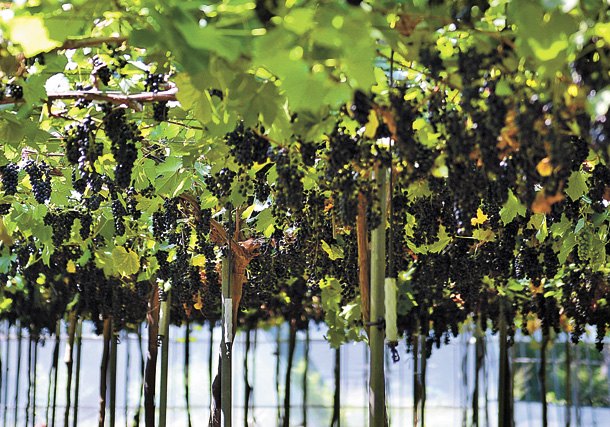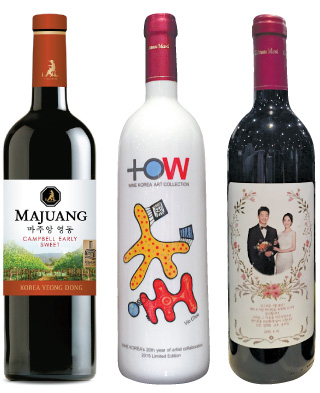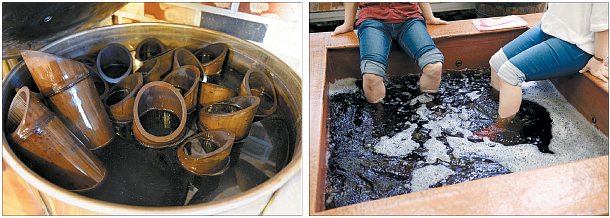Innovation in the heart of Korea’s wine country : This weekend’s Yeongdong Wine Festival celebrates the diversity of a young industry

A view of the vineyard at Country Wine, Yeongdong County in North Chungcheong.[LIETTO]
An extraordinary place to savor an outdoor meal and some wine is a local vineyard. While Korea is not known to be a wine-producing country, you wouldn’t know that after a visit to Yeongdong County, which is designated as a grape and wine district by the local government. The region offers experiences that most assume could only be found when traveling abroad.
Driving out to the quieter countryside, walking along the vineyards and picking some grapes from the vine to taste aren’t the only things you can do while visiting wineries. Located about two and a half hours from Seoul, the vineyards offer not only tours and tastings, but also wine foot baths and beautiful locations for wedding receptions.
To introduce visitors to the area’s wineries and the wines that are produced in the country, Yeongdong County is holding the Yeongdong Wine Festival, beginning today.

Majuang Yeongdong, left, Lotte Chilsung Beverage’s wine made with grapes grown in Yeongdong County. In the middle is a porcelain wine bottle made by Wine Korea. The winery also makes custom-made wine labels, seen at right. [LOTTE CHILSUNG BEVERAGE, LEE SUN-MIN]
To tackle the excessive production of grapes, the Korean government offered another way for farmers to make use of the fruits. The move started as the country saw cheaper imported grapes from countries like Chile garnering local consumers’ attention in early to mid-2000s.
The government designated Yeongdong as the Special District for Grapes and Wine in 2005, and assisted farmers in setting up wine-making facilities since 2008. Since then, the majority of the grape farmers have started to make, bottle and label their own wines, while some growers have been making small quantities of their own alcoholic beverages with the grapes at home for decades. Currently within the county, 42 small-size wineries and one large, corporation-style winery produce wine.
Thanks to the early development of wine-making skills in Korea, the county also has many different educational institutions and research centers to study how to create sustainable growth for the wine industry here. Many sons and daughters of winemakers take classes at U1 University, located in Yeongdong. There, students can study winemaking before they make plans to go overseas and learn from other wine-producing countries.
To promote local wine across the country through bigger retail stores, the county joined forces with Lotte Chilsung Beverage last year. Grapes from Yeongdong are used to make the company’s wine Majuang, which was first introduced in 1977.
The difference in Korean wine
Cabernet sauvignon, merlot, chardonnay, and riesling are varieties that even novice wine drinkers have heard of at least once or twice, as these are some of the most popular grapes around the world used to make wine.
However, most likely, the wines made with these grapes won’t be found in Korea at this time because most wines produced domestically are made with Campbell Early, a grape that makes red wine. Some whites made with varieties called cheongsu, cheongporang or shine muscat are available as well, but are not as widely available as red wines.
“The particular red variety is known for its strong sweet scent that many locals are already familiar with,” said Kim Duok-hyeon, president of Country Wine, one of the oldest wineries in the county. Locally, the grapes used to make wine is the same variety of grape that is commonly sold for eating - a practice that is uncommon in more famous wine-producing countries.
“The familiar smell and sweet taste made it easy for those who don’t drink wine often to think that wine drinking isn’t so foreign.”
Local winemakers have of course tried out international varieties or experimented with different ways of forming the vines, inspired by farmers from countries known for their wine. Some winemakers are even trying to plant international grape varieties on their own.
“The soil the grapes are planted in is very fertile, which gives vines no reason to make their roots go deeper for nutrition, and that makes it difficult for vines to survive the harsh winter weather here,” said Kim of Country Wine.
Sinabro, a small winery, adopted a skill that is used in northern Italy to make wine. It makes dry wine with dried Campbell Early grapes to get a deeper flavor. While the Italian way is to harvest the grapes and then dry them, here winemakers keep the grapes on the vines and dry them there. Seeing steady sales, even the farmer’s son and daughter-in-law are becoming more interested in participating in the winemaking process. They are thinking about going to Germany to learn more about making white wine, as their winery is one of few known for its white wines.
The winery recently received an accolade for its newest sparkling wine at the Asia Wine Trophy earlier this month, an event that evaluated wines available in Korea. The winemaking couple said that they will now seek ways to make sparkling wine at a more affordable price. They hope to offer the wine for around 5,000 won ($4.44) - an impressive price as many local wines range around 20,000 won to 30,000 won, with some premium wines selling for around 50,000 won.

Left: Wine produced at Chateau Miso are on display. Middle: The wine cellar at Wine Korea, which produces Chateau Mani, is decorated with wines in oak barrels. Right: Winemakers at Sinabro have set up a bar so visitors can enjoy a relaxed vibe.[LIETTO]
While many small size wineries focus on offering small activities like making mulled wine, Wine Korea, which has the largest wine production in the county, offers more unique experiences for visitors coming to try out its flagship wine, Chateau Mani.
The vineyard offers wedding receptions out in the garden - president of the company, Yun Tae-rim, got married there earlier this month. Yun made a special label to put on the bottles of wine served at his wedding, just as the winery did when his sister got married. The same service is available to anyone who requests it.
“For those who want to make their special day even more memorable, we make custom labels for no additional charge,” said Yun, who takes care of the business side of the winery while his father, who started the business, spends more time farming.
Wine Korea offers porcelain wine bottles, a nod to the past, when porcelain containers were commonly used for alcoholic beverages, and even plastic wine bottles, so that it is easier for younger customers to carry when going on picnics.
“The wine doesn’t need to be consumed the same way it is consumed abroad, where there is a long history of wine drinking,” said Yun. “It is important to encourage people to enjoy wine however they want, and we are here to accommodate those needs for local consumers.”
At Wine Korea, visitors can also enjoy foot baths in wine, eat lunch and dinner in a house with a roof made of vines, and even stay the night so that they don’t have to worry about driving back home after having a drink or two. To cater to more visitors interested in spending the night at the winery, Yun is creating camping grounds on the property.
Winemakers at Chateau Miso tries maturing their wines in different ways. Instead of using stainless steel, American or French oak barrels, the winery is using oak barrels made in Korea and even trying out different materials such as bamboo.

Left: Winemakers at Chateau Miso try out different ways to mature wine, including using bamboo shoots. Right: Wine Korea and many other wineries in Yeongdong offer wine foot baths. [LIETTO]
There is no better opportunity to check out the many different wines produced in Yeongdong than taking a visit to this weekend’s festivities. The Yeongdong Wine Festival will provide the many different wines made in the Yeongdong region for only 3,000 won. Visitors can simply purchase a glass for 3,000 won, and stop by each booth to taste the wines each winery has on offer. The festival runs until Sunday.
BY LEE SUN-MIN [summerlee@joongang.co.kr]










with the Korea JoongAng Daily
To write comments, please log in to one of the accounts.
Standards Board Policy (0/250자)